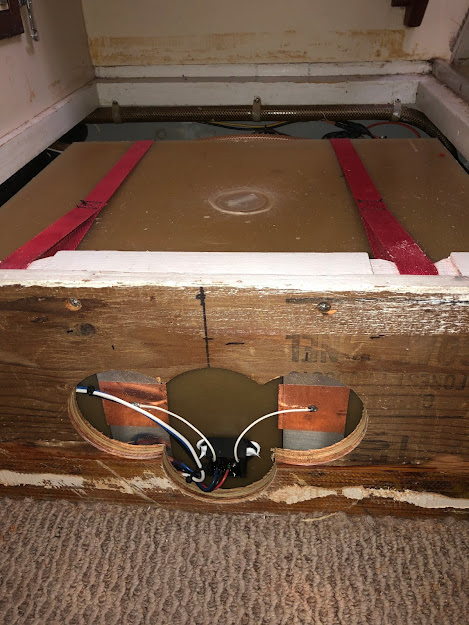When the S**T hits the Can
I love almost everything about this boat...almost everything. The Camano's one short coming is the holding tank. I think it is on the small side.
The Camano has 2 fuel tanks @ 50 gallons each & 2 water tanks @ 35 gallons each. The newer models (this is a 2000) had slightly larger fuel tanks installed. I'm fine with the 100 gallons & at our cruise speed of 8 - 9 knots we burn about 1.9 gph which gives us about a 400 + mile range. Considering we only travel 40 - 50 miles a day, that is a long way between fuel stops.
Back to the holding tank. I believe a tank monitor of some sort is critical. There are many on the market and I have had a few of them. My last one had a sensor that went into the tank. The problem with that type is debris can build up on the sensor and can either stop working or give you a false reading. I did some research and found that the Solo 1-Tank Monitor from New Providence Marine Systems (a link to their website is at the end) was a system a lot of folks seemed to be happy with. I chose it because it got good reviews & it was reasonably priced.
The company makes several displays and I chose one of the simpler ones. The Solo 1-Tank in the "Profile" configuration. Meaning it mounts under counter. They also manufacture a flush mount as well. The solo comes with a few options, a standard read & also a "Tank Full" light warning users "that's it, take your poop elsewhere" and also a "Tank Empty" that can be used with water storage. The system comes with an external non-contact fluid sensor or can be used with contact, internal sensors, floats, etc.
The non-contact sensor is for plastic (HDPE or LDPE) tanks only and Can Not be used on aluminum or steel tanks. For that type of tank you would need an internal sensor.
I needed access to an area of the tank to install the sensor and the only option was on the front. I removed the carpet on the front of the step and removed the 4 screws that held the piece of wood with straps holding down the tank. The front of the tank was up against the step so i used a hole saw to provide clearance for the sensor.
I drilled an initial hole in the front of the step for clearance of the sensor.
I cleaned the area for the sensor with alcohol, marked where the foil tape was to be placed. It should be 3" - 4" apart and 1/2" from the bottom & 1/2" from the top of the tank. Adhered the foil tape in place, then adhered the sensor with it's 2 copper tape pieces to the foil. Both the sensor & the tape has a pretty sticky backing. For an added measure I placed 2 dots of silicone where the sensor had screw type holes. Also, the instructions recommend "over spraying" the edges of the foil tape with spray adhesive. I did that as well.
I drilled more holes to provide adequate space for the sensor. I followed the wiring instructions, made my connections and fished the wires back to the display.
After mounting & connecting the display, the next task was to calibrate the unit. For the Profile type unit, the bottom is removed to provide access to the "Empty" & "Full" buttons that are used to calibrate the unit.
Calibration is pretty straight forward.
Software Setup: 1. Set the type of sensor, either External Foil, Solid State Rod or 33-240 Ohm Float 2. Set the shape of the tank, Square, Tapered Cross Section, More Tapered Cross Section or Circular Cross-Section.
Once that is complete, you have to Calibrate Empty & Full. I started by flushing my tank out several times then pumped it out to calibrate Empty. Once complete, I filled my tank with 14 gallons of water (I measured it out in buckets and flushed the 14 gallons), then calibrated it as FULL. At Full, the Red "Tank Full" light stays on warning you the tank is at it's capacity.
The manufacturer says the software set up & calibration will remain in the unit even when power has been turned off.
The last thing I did was to install a new "finished" step front and that will provide both a cover & access to the the sensor with a small window to view the sensor/power light.
The system was $164.95 with shipping. Reasonable I think. Many of the other systems I looked at were much more. Time will certainly tell if the money and effort was worth it.
Here is a link to New Providence Marine Systems
http://www.newprovidencemarine.com/product.html











Comments
Post a Comment